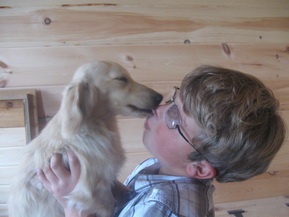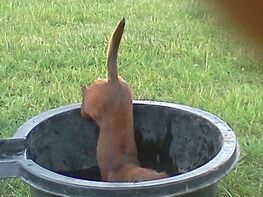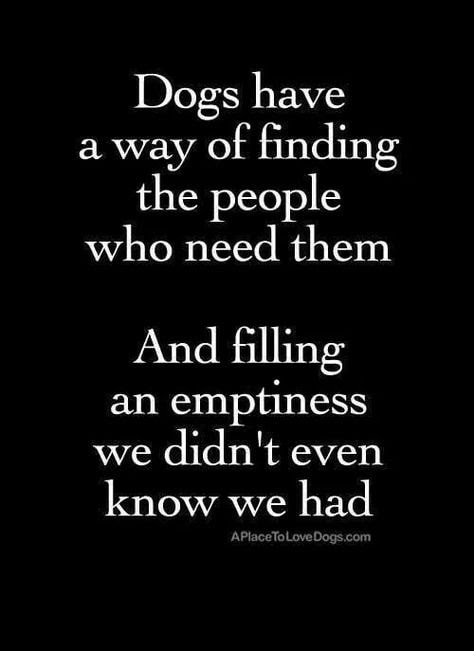Meet the Dachshund

Dachshunds come in many varieties. There are different sizes and colors as well as types of coat to choose from, each with its own characteristics and group of devoted owners and admirers.
Dachshunds are long-bodied, short-legged dogs--small in stature but very large in personality--whose noses are so close to the ground that not much escapes their notice! In fact, their physical structure is the primary reason for their hunting expertise. This scenting ability was recognized by German hunters as early as the 15th century.
Derived from early German hounds known as Deutsche Brocken, these little dogs were called badger dogs or diggers. Eventually they were crossed with small terrier-type dogs to produce the Dachshunds we know today. With the nose of the hound, the long, low body that burrows into holes in the ground and the fearless terrier-like enthusiasm for the chase, the Dachshund is hard to beat.
Miniatures originally weighed from 16 to 25 pounds and hunted fox or tracked wounded deer. Today, the average Miniature weighs from 8 to 12 pounds and hunts rabbit or hare. Standards are sized between 16 to 32 pounds. In America, Dachshunds have not been used for hunting or tracking but the dogs' sterling qualities of lively character, courage and devotion have always made them popular.
In 1885 AKC recognized the Dachshund as part of the hound group. 1913, Dachshunds were listed among the ten most popular breeds in America. When World War I began, Dachshund interest declined and remained low until the early 1930's. By 1940, they were again ranked among the top ten breeds in America and maintained that standing into the 21st century.
Dachshunds are long-bodied, short-legged dogs--small in stature but very large in personality--whose noses are so close to the ground that not much escapes their notice! In fact, their physical structure is the primary reason for their hunting expertise. This scenting ability was recognized by German hunters as early as the 15th century.
Derived from early German hounds known as Deutsche Brocken, these little dogs were called badger dogs or diggers. Eventually they were crossed with small terrier-type dogs to produce the Dachshunds we know today. With the nose of the hound, the long, low body that burrows into holes in the ground and the fearless terrier-like enthusiasm for the chase, the Dachshund is hard to beat.
Miniatures originally weighed from 16 to 25 pounds and hunted fox or tracked wounded deer. Today, the average Miniature weighs from 8 to 12 pounds and hunts rabbit or hare. Standards are sized between 16 to 32 pounds. In America, Dachshunds have not been used for hunting or tracking but the dogs' sterling qualities of lively character, courage and devotion have always made them popular.
In 1885 AKC recognized the Dachshund as part of the hound group. 1913, Dachshunds were listed among the ten most popular breeds in America. When World War I began, Dachshund interest declined and remained low until the early 1930's. By 1940, they were again ranked among the top ten breeds in America and maintained that standing into the 21st century.
Characteristics of the Dachshund

Possessing a friendly, companionable personality, the Dachshund charms his way into the hearts of all who get to know him.. The fact that Dachshunds love people, especially children and the elderly, endears them to the general population.
Dachshunds are odorless and exceptionally clean dogs. The miniature is mature by 12 months of age. Dachshunds are exceptionally long-lived dogs, with many living until 14 to 17 years of age. Regardless of size or variety, the Dachshund is easily maintained and managed, thus making it a most desirable companion.
Dachshunds are very social dogs, though they are often particularly devoted to one owner. Because of the Dachshund's intelligence and versatility, the ideal owner is a person who has time to spend with his dog. Dachshunds do best when they're mentally stimulated and made to feel appreciated and like members of the family.
Dachshunds are odorless and exceptionally clean dogs. The miniature is mature by 12 months of age. Dachshunds are exceptionally long-lived dogs, with many living until 14 to 17 years of age. Regardless of size or variety, the Dachshund is easily maintained and managed, thus making it a most desirable companion.
Dachshunds are very social dogs, though they are often particularly devoted to one owner. Because of the Dachshund's intelligence and versatility, the ideal owner is a person who has time to spend with his dog. Dachshunds do best when they're mentally stimulated and made to feel appreciated and like members of the family.
- Dachshunds come in two sizes – Standard and Miniature, and three coats – Smooth Haired, Long Haired and Wire Haired. The smooth coat is short, sleek and easy to care for. The long coat is the most glamorous and requires regular grooming. This involves brushing the coat weekly, and trimming the feet at regular intervals. The wire coat is short, compact and harsh to touch and a regular visit to a grooming salon will ensure the dog always looks his best
- Dachshunds come in a variety of colors. The most common are Red, that can vary from a pale cream through to a dark shaded mahogany and Black and Tan. Sometimes breeders have Chocolate or Dappled puppies for sale. Wires can have a brindle coat.
- Reputable breeders do not sell puppies under 8 weeks of age. Puppies should have been regularly wormed, and have received their first immunization. The Veterinarian thoroughly checks out the puppy. It is important that the new owner ensures that immunization boosters are administered when they fall due, and that their puppy is wormed every three months.
- A Dachshund’s lifespan averages between 10-20 years. Regular exercise is a must. Dachshunds become bored hanging around the yard and are enthusiastic eaters. They are quite happy to spend their life on your favorite chair so for the dog’s well being exercise is recommended.
- Diet can vary. Some breeders recommend fresh meat plus a good quality dry food. When you buy your puppy be sure to ask the breeder about the diet regime. As a guide miniatures could cost around $10 a week to feed, standards around $15.
- As a general guide to a Dachshund’s temperament, Smooths firmly believe they should run the household. Longs have wonderful natures and Wires are extroverts that love to be around people and enjoy life. A word of caution – if you want a dog that will be put out into a yard and ignored – a Dachshund is not for you.
- Whilst a Dachshund is only a small dog it is very hardy. Because of its long body, in relation to its height some Dachshunds could suffer from a prolapsed disc. This problem is most likely to occur between the ages of 4 and 7 years. The importance of regular exercise, and not allowing the dog to become overweight cannot be ignored. Your breeder will be able to advise you of ways to reduce the risk of this potential problem.
What is this PRA all about?
Progressive Retinal Atrophy Cord1 Mutation in Miniature Long and Miniature Smooth Dachshunds
Progressive Retinal Atrophy (PRA) is a term for retinal degenerations occurring in many breeds of dogs. The disease results in a degeneration of the light-sensitive membrane at the back of the eye – the retina – resulting in loss of vision, and often leading to blindness.
PRA has been diagnosed in all varieties of Dachshunds but there has been a predominant incidence in the mini long haired variety. Up until the beginning of 2005, canine ophthamologists could only diagnose whether or a mini long dachshund had PRA or did not have PRA at the time of the test. Breeders had no indication as to the carrier status of their dogs. Although there is rare incidence of blindness in mini smooths The AHT have discovered that they too can carry the gene muation and have accordingly developed a test for mini smooths.
Following many years of research the Genetics Services Division of Animal Health Trust in Suffolk, United Kingdom have developed a DNA test that identifies three important factors to eliminate this disease.
Affected – dogs that have no clinical symptoms but will develop the disease assuming they live to an appropriate age.
Carriers – dogs that have the mutation of the gene. They will never develop the disease but would pass the gene on to 50% their offspring.
Clear dogs – these dogs do not carry this mutation of the gene and will never develop PRA.
Breeders now have information to guide their future direction as responsible custodians of the breed.
How does this affect the puppy buyer?
Can you safely buy a mini long or mini smooth puppy as a pet?
The answer is yes. Discuss the latest scientific findings with your breeder.
It is imperative that pet owners not breed from a dog that is PRA Affected or a PRA Carrier.
For more information go to http://www.aht.org.uk/genetics_dachpra.html or contact the Dachshund Club of NSW Inc PRA Co-ordinator Jan Gardiner
http://dachclubqld.netfirms.com/html/pra__register.html
Progressive Retinal Atrophy Cord1 Mutation in Miniature Long and Miniature Smooth Dachshunds
Progressive Retinal Atrophy (PRA) is a term for retinal degenerations occurring in many breeds of dogs. The disease results in a degeneration of the light-sensitive membrane at the back of the eye – the retina – resulting in loss of vision, and often leading to blindness.
PRA has been diagnosed in all varieties of Dachshunds but there has been a predominant incidence in the mini long haired variety. Up until the beginning of 2005, canine ophthamologists could only diagnose whether or a mini long dachshund had PRA or did not have PRA at the time of the test. Breeders had no indication as to the carrier status of their dogs. Although there is rare incidence of blindness in mini smooths The AHT have discovered that they too can carry the gene muation and have accordingly developed a test for mini smooths.
Following many years of research the Genetics Services Division of Animal Health Trust in Suffolk, United Kingdom have developed a DNA test that identifies three important factors to eliminate this disease.
Affected – dogs that have no clinical symptoms but will develop the disease assuming they live to an appropriate age.
Carriers – dogs that have the mutation of the gene. They will never develop the disease but would pass the gene on to 50% their offspring.
Clear dogs – these dogs do not carry this mutation of the gene and will never develop PRA.
Breeders now have information to guide their future direction as responsible custodians of the breed.
How does this affect the puppy buyer?
Can you safely buy a mini long or mini smooth puppy as a pet?
The answer is yes. Discuss the latest scientific findings with your breeder.
It is imperative that pet owners not breed from a dog that is PRA Affected or a PRA Carrier.
For more information go to http://www.aht.org.uk/genetics_dachpra.html or contact the Dachshund Club of NSW Inc PRA Co-ordinator Jan Gardiner
http://dachclubqld.netfirms.com/html/pra__register.html
marebelladachshunds@gmail.com or call Mary 9895064378





